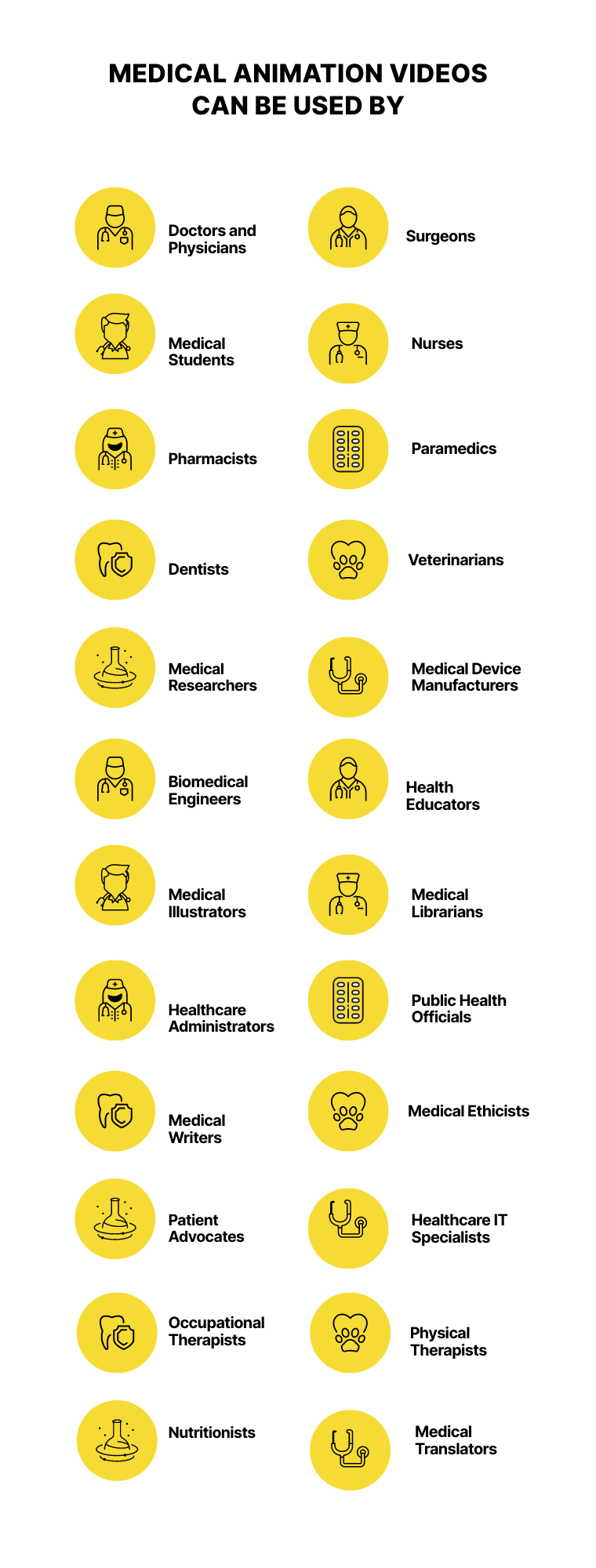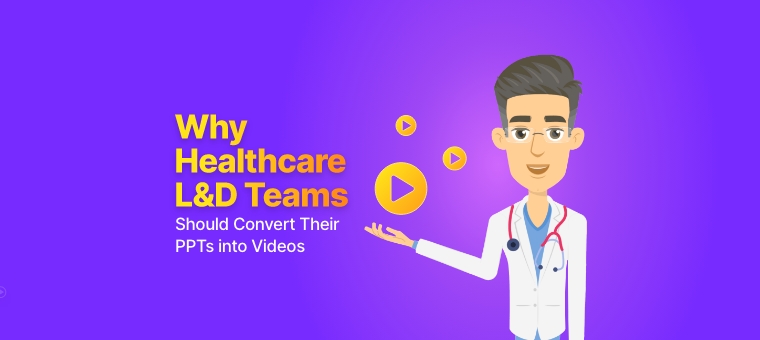Why Healthcare L&D Teams should Convert their PPTs into Videos
The healthcare industry is constantly evolving, with new technologies and treatments emerging constantly.
You also know that a well-trained workforce should stay up-to-date on the latest advancements!
This is where Learning and Development (L&D) professionals in healthcare come into the picture.😎
L&D teams are the ones who train, learn and make learning better and better every day for their employees.
... and they start creating effective training materials that can educate and engage healthcare staff.
For many years, PPTs have been the go-to format for healthcare L&D teams. They may be easy to create and share, and of course, PPTs can contain a lot of information (which can go unnoticed most of the time). However, they also have some significant drawbacks, as training materials. TRUE!😐

Learning and Development department plays a significant role in creating engaging and effective educational materials. Among the various formats available, animated medical videos are emerging as a powerful tool. Videos simplify complex concepts, enhance engagement, and improve retention.
The healthcare industry consists of
- hospitals,
- medical devices,
- clinical trials,
- outsourcing,
- telemedicine,
- medical tourism,
- health insurance,
- medical equipment, and so on.
Creating a PPT requires a lot of assistance, research, and selection of good stock images that are relevant and have many human works, which explains that there are limitations to creating one. They do not help in the modern workforce. Let me tell you WHY, in this blog.
Here's what you'll get to see:
- The Challenges with PPTs in Healthcare Training
- Why Do Animated Medical Videos Play a Major Role in Healthcare?
- The Power of Video for Healthcare Training
- 17 Top Reasons why L&Ds from the Healthcare Industry are switching from PPT to Training Videos
- Animaker: Your Partner in Healthcare Video Creation
- How to convert your PPT into Video using Animaker
The Challenges with PPTs in Healthcare Training
- Passive Learning: PPTs are a passive learning format. Learners simply read the text and look at the images, which can lead to disengagement and difficulty retaining information.
- Inflexibility: PPTs are static documents that cannot be easily updated. This can be a problem in the healthcare industry, where information is constantly changing.
- Accessibility Issues: PPTs can be difficult for people with disabilities to access. For example, people with visual impairments may have trouble reading the text, and people with mobility impairments may have trouble navigating the document.
People retain 95% of information from visuals compared to 10% from text alone.
Let’s start with why animated medical videos are significant for healthcare training.
Why Do Animated Medical Videos Play a Major Role in Healthcare?
Animated medical videos are revolutionizing healthcare training for several reasons:
- Enhanced Understanding: Medical concepts can be intricate and challenging to grasp. Animation simplifies these complexities by visually representing processes, anatomy, and procedures in an easy-to-understand format.
- Increased Engagement: Traditional training materials can be monotonous. Animated videos captivate learners’ attention, making the training experience more enjoyable and memorable.
- Better Retention: Visual content is processed faster and retained longer than text. Animated videos help healthcare professionals retain crucial information, leading to better application in real-world scenarios.
- Consistency in Training: Animated videos ensure consistent delivery of training content, eliminating variations that might occur with live trainers.
- Accessibility: These videos can be accessed anytime, anywhere, providing flexibility for busy healthcare professionals.
Medical animation videos can be utilized by a wide range of professionals across various fields. Here are around 24 professions that can benefit from medical animation videos:

- Doctors and Physicians: For patient education and surgical planning.
- Surgeons: To visualize complex procedures.
- Medical Students: For learning anatomy, physiology, etc.
- Nurses: For patient education and training.
- Paramedics: For training on emergency procedures.
- Pharmacists: To understand drug mechanisms and interactions.
- Dentists: For patient education and procedural understanding.
- Veterinarians: To explain animal anatomy and procedures to pet owners.
- Medical Researchers: For visualizing scientific concepts.
- Medical Device Manufacturers: To demonstrate product functionality.
- Biomedical Engineers: For design and development visualization.
- Health Educators: To create engaging educational content.
- Medical Illustrators: To enhance visual communication in medical publications.
- Medical Librarians: For digital resources and educational support.
- Healthcare Administrators: To explain policies and procedures to staff and patients.
- Public Health Officials: For health promotion campaigns.
- Medical Writers: To enhance articles and publications with visual aids.
- Medical Ethicists: To illustrate ethical dilemmas and decisions.
- Patient Advocates: To educate patients about their conditions and treatments.
- Healthcare IT Specialists: To develop interactive medical education tools.
- Occupational Therapists: For patient education on therapeutic exercises.
- Physical Therapists: To demonstrate rehabilitation techniques.
- Nutritionists: To illustrate dietary recommendations and effects on the body.
- Medical Translators: To provide visual aids for translated medical content.
The Power of Video for Healthcare Training
Videos offer a number of advantages over PPTs for healthcare training.
97% of L&D professionals find video more effective than text-based documents for knowledge retention.
- Active Learning: Videos can promote active learning by engaging multiple senses (sight and sound). This can lead to better information retention and understanding.
- Engaging Content: Videos can be more engaging and interesting than PPTs. They can use a variety of elements, such as animation, narration, and real-world footage, to capture and hold learners' attention.
- Microlearning: Videos can be broken down into short, bite-sized chunks, which is ideal for busy healthcare workers. Microlearning allows learners to focus on one concept at a time and improves knowledge retention.
- Accessibility: Videos can be made accessible to people with disabilities by using captions, transcripts, and audio descriptions.
16 Top Reasons why L&Ds from the Healthcare Industry are switching from PPT to Training Videos
Ever wondered how healthcare professionals stay sharp and prepared in such a fast-paced industry?
Imagine this: there’s a nurse on a busy hospital floor, a doctor navigating the latest medical tech, or an administrative staff member ensuring seamless patient experiences. How do they keep up with it all?
The magic happens behind the scenes, thanks to the L&D departments, who creates efficient training video materials, that stands tall in their minds, helpding them remember things easily.

Source: Forrester Research
L&Ds in the healthcare industry create videos and training materials for a variety of critical reasons. Here are 16 key reasons:
- Compliance Training: Ensuring healthcare staff adhere to the latest regulations and protocols is crucial. Videos can effectively communicate complex compliance requirements in an engaging and memorable way.
- Virtual Care (for patients): Videos can empower patients by providing clear instructions on using telehealth technologies, understanding post-procedure care, or managing chronic conditions at home.
- Medical Training: From new surgical techniques to the latest diagnostic procedures, videos can visually demonstrate complex medical processes for residents, fellows, and practicing physicians.
- Provider Training for Franchisee Education: Maintaining consistent standards across a network of healthcare providers is essential. Videos offer a standardized approach to training franchisees on protocols, best practices, and brand messaging.
- Updates in the Industry: The healthcare industry is constantly evolving. Videos can efficiently disseminate updates on new drugs, treatment protocols, and medical research findings to a wide audience.
- Training the Frontline Staff: Nurses, receptionists, and other frontline staff play a vital role in patient care. Videos can effectively train them in communication skills, handling emergencies, and following proper safety protocols.
- Soft Skills Development: Effective communication, empathy, and teamwork are essential for healthcare professionals. Videos can provide realistic scenarios and role-playing exercises to hone these soft skills.
- Product or Equipment Training: Introducing new medical devices or technologies often requires specific training. Videos can visually demonstrate proper usage, troubleshooting steps, and safety precautions.
- Patient Education: Videos can empower patients by providing clear explanations of diagnoses, treatment options, and potential side effects in a way that is easy to understand.
- Continuing Medical Education (CME): Healthcare professionals are required to complete CME credits to maintain their licenses. Videos can offer a flexible and engaging way to fulfill these requirements.
- Mental Health Awareness: Videos can be a powerful tool for destigmatizing mental health conditions and educating staff on how to identify and support patients experiencing mental health concerns.
- Safety Protocols: From proper handling of hazardous materials to fire safety procedures, videos can clearly demonstrate essential safety protocols for healthcare staff in various settings. 13. Diversity and Inclusion Training: Fostering a welcoming and inclusive environment for patients and staff is crucial. Videos can effectively promote cultural competency and unconscious bias training.
- Public Health Awareness Campaigns: Raising awareness about critical public health issues like vaccinations, infectious diseases, and preventive care can be effectively achieved through engaging video campaigns.
- Simulation Training: Videos can create realistic simulations of medical emergencies or challenging scenarios, allowing healthcare professionals to practice their decision-making and response skills in a safe environment.
- Onboarding New Staff: The initial onboarding process can be overwhelming for new healthcare workers. Videos can efficiently introduce them to the company culture, facility layout, and key policies and procedures, easing the transition into their new role.
- Performance Improvement: Videos can be used to identify areas for improvement in specific skills or procedures. By incorporating real-world examples and expert demonstrations, L&Ds can create targeted training materials to address performance gaps.
Animaker: Your Partner in Healthcare Video Creation
Animaker is a user-friendly animation and AI video creation platform that is perfect for healthcare L&D teams.
With Animaker, you can create a variety of professional-looking videos, even if you have no prior animation experience.
Animaker offers a library of pre-built templates, characters, and assets specifically designed for the healthcare industry. More importantly, we have built exclusive AI capabilities that can make your video creation process much much much easier and engaging on a variety of healthcare topics.
How to convert your PPT into Video using Animaker
Step 1: Click here to access Animaker’s PPT to Video Converter page. Click on the ‘Convert PPT to Video now’ button.

Step 2: Sign in if you have an account or else sign up.
Step 3: This will take you to the page where you can upload your PPT.

If it doesn’t take you to the above-seen page, then login/sign up here. Click on Create -> Create a video -> Blank Page.

Here, click on ‘File’ from the top left -> Click on ‘PPT to video’.

Step 4: You can simply import your PPT file -> make necessary content changes -> add animations or customize it based on your requirements.
Step 5: You can download the file as a video.
Publish -> Download Video -> Edit ‘Video Name’, Download Options and File Type -> Download.

Your boring PPT now has become a stunning video!
By following these tips, you can use Animaker to convert your standard PPTs into engaging and effective video training materials for your healthcare workforce.
The use of video in healthcare training is on the rise. Videos offer a number of advantages over traditional training methods, such as PPTs. By converting your PPTs into videos, you can create more engaging and effective training materials that will help your healthcare workers learn and retain information more effectively.
So why not give it a try today?
Book a Demo with us today, & we will show you how to convert your PPTs into Animation Training Medical Videos.



